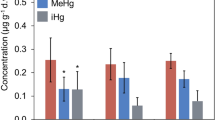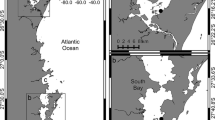Abstract
From previous work, the equilibrium concentration factor for dissolved mercury in the digestive gland of Ostrea edulis Linnaeus was found to be three to four times higher than that in the gills. In the present study, an analysis of soluble protein revealed values of 49.3±14.2 mg g wet tissue-1 for the digestive gland and 0.7 ±0.1 mg g wet tissue-1 for the gills. Starvation significantly reduces the soluble protein level of the digestive gland to 31.1±6.4 mg g-1 and that of the gills to below the limit of detection. These results suggest that the difference in concentration factors between the gills and digestive gland may be based on a quantitative difference in macromolecular binding sites. However, the uptake of dissolved mercury over a period of 48 h was considerably greater in the gills, so that although the soluble protein content of the tissue may influence the final concentration factor, it does not appear to affect the rate at which this equilibrium is achieved. A more detailed investigation of the mechanism of dissolved mercury uptake by oyster gills has been carried out using isolated tissues. The process is inhibited by 5mM 2–4 dinitrophenol, by the absence of a readily metabolizable substrate (dextrose) in the uptake medium, and by 30mM K+. The effect of K+ necessitated further investigation with a specific inhibitor of K+ transport. Strophanthin G (ouabain), at a concentration of 0.01 mM, caused a significant increase in mercury uptake.
Similar content being viewed by others
Literature Cited
Aboad, L.G., K. Koketsu and K. Noda: Effect of dinitrophenol on phosphorylation and bioelectric phenomena of excitable tissue. Am. J. Physiol. 200, 431–436 (1961)
Charnock, J.S. and R.L. Post: Evidence of the mechanism ouabain inhibition of cation activated adenosine triphosphatase. Nature, Lond. 199, 910–911 (1963)
Chipman, W.A., T.R. Rice and T.S. Price: Uptake and accumulation of radioactive zinc by marine plankton, fish and shellfish. Fishery Bull. Fish Wildl. Serv. U.S. 58, 279–292 (1958)
Coombs, T.L.: The nature of zinc and copper complexes in the oyster Ostrea edulis. Mar. Biol. 28, 1–10 (1974)
Corner, E.D.S. and B.W. Sparrow: The mode of action of toxic agents. I. Observations on the poisoning of certain crustaceans by copper and mercury. J. mar. biol. Ass. U.K. 35, 531–548 (1956)
Davies, A.G.: The kinetics of and a preliminary model for the uptake of radio zinc by Phaeodactylum tricornutum in culture. In: Radioactive contamination of the marine environment, pp 403–420. Vienna: International Atomic Energy Agency 1973
Leggett-Baily, J.L.: Techniques in protein chemistry, 2nd ed. 406 pp. Amsterdam: Elsevier 1962
Ling, G.N.: A physical theory of the living state, 680 pp. Boston, Mass.: Ginn (Blaisdell) 1962
Park, J.H.: Glutathione and ethylenediamine tetra-acetate antagonism of uncoupling of oxidative phosphorylation. Biochim. biophys. Acta 22, 403–404 (1956)
Parker, R.E.: Introductory statistics for biology, 122 pp. London: Edward Arnold 1973
Passow, H. and A. Rothstein: The general pharmacology of the heavy metals. Pharmac. Rev. 13, 185–224 (1961)
Pentreath, R.J.: The accumulation from water of 65Zn, 54Mn, 58Co and 59Fe by the mussel, Mytilus edulis. J. mar. biol. Ass. U.K. 53, 127–143 (1973)
Robertson, J.D.: Further studies on ionic regulation in marine invertebrates. J. exp. Biol. 30, 277–296 (1953)
Romeril, M.G.: The uptake and distribution of 65Zn in oysters. Mar. Biol. 9, 347–354 (1971)
Smith, J.D., R.A. Nicholson and P.J. More: Mercury in the water of the tidal Thames. Nature, Lond. 232, 393–394 (1971)
Whittam, R. and M.E. Ager: The connexion between active cation transport and metabolism in erythrocytes. Biochem. J. 97, 214–227 (1965)
Wolfe, D.A.: Zinc enzymes in Crassostrea virginica. J. Fish. Res. Bd Can. 27, 59–69 (1970)
Wrench, J.J.: Biochemical aspects of the uptake of mercury and selenium by the native British oyster Ostrea edulis, 104 pp. Ph.D. Thesis, University of Southampton 1977
Author information
Authors and Affiliations
Additional information
Communicated by J.M. Pérès, Marseille
Rights and permissions
About this article
Cite this article
Wrench, J.J. Biochemical correlates of dissolved mercury uptake by the oyster Ostrea edulis . Mar. Biol. 47, 79–86 (1978). https://doi.org/10.1007/BF00397021
Accepted:
Issue Date:
DOI: https://doi.org/10.1007/BF00397021




